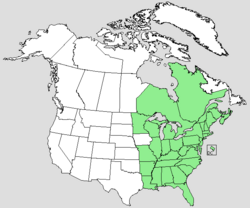Biology:Medeola
| Medeola | |
|---|---|

| |
| Flowering | |
| Scientific classification | |
| Kingdom: | Plantae |
| Clade: | Tracheophytes |
| Clade: | Angiosperms |
| Clade: | Monocots |
| Order: | Liliales |
| Family: | Liliaceae |
| Subfamily: | Lilioideae |
| Tribe: | Medeoleae |
| Genus: | Medeola L. |
| Species: | M. virginiana
|
| Binomial name | |
| Medeola virginiana | |

| |
| USDA distribution map[2] | |
| Synonyms[3] | |
| |
Medeola virginiana, known as Indian cucumber,[2][4] cucumber root,[5] or Indian cucumber-root,[6][7][8] is an eastern North American plant species in the lily family, Liliaceae.[2] It is the only currently recognized plant species in the genus Medeola.[9] It grows in the understory of forests. The plant bears edible rhizomes that have a mild cucumber-like flavor.[10]
Description
Medeola virginiana shoots consist of two tiers of whorled leaves. The lower tier typically bears between five and nine (occasionally up to 12) lance shaped leaves. The upper tier bears three to five ovate leaves. The leaves have an entire (smooth) margin. Some individuals lack a second tier of whorled leaves. The second tier is produced when the plant flowers. When two-tiered, plants grow to 30 in (76 cm) high. The flowers have yellowish green tepals and appear in late spring. The fruit is a dark blue to purple, inedible berry above the top tier of leaves.[9][11][12] Indian cucumber-root shoots arise each spring from an overwintering tuberlike structure. This structure produces a series of horizontal rhizomes at 45 degree angles which produces a clonal colony of plants in an octagonal pattern.[13]
Taxonomy and systematics
The genus Medeola was formerly associated with the lilioid genera Trillium and Paris, which are now placed in the tribe Paridae of the family Melanthiaceae in the order Liliales. Armen Takhtajan separated Medeola from Trillium and Paris, and placed it in its own family, Medeolaceae, which he erected in 1987,[9] based on a description that had been published in 1879 by Sereno Watson.[citation needed] The genera Medeola and Clintonia now constitute the tribe Medeoleae of the subfamily Lilioideae in the family Liliaceae, as narrowly defined in the APG IV system.[citation needed] Molecular, morphological, embryological, and cytological evidence supports a sister relationship between Medeola and Clintonia. The Flora of North America includes both of these in the family Liliaceae.
Some species of Asparagus were formerly placed in the genus Medeola, including:[3]
- Medeola angustifolia now Asparagus asparagoides
- Medeola asparagoides now Asparagus asparagoides
- Medeola latifolia now Asparagus asparagoides
- Medeola triphylla now Asparagus declinatus
Distribution and habitat

Medeola virginiana is found from Ontario to Nova Scotia, south to Florida, and Louisiana.[3] It grows in rich, moist forests, thickets, and woodlands.[9][14]
It is listed as an endangered plant in Florida and in Illinois.[2]
Uses
This plant produces a crisp, edible tuber that smells and tastes like garden cucumber;[15] it can be washed and eaten raw or cooked.[16] Iroquois used the plant as an anticonvulsant and pediatric aid.[17]
References
- ↑ "Medeola virginiana". NatureServe Explorer. NatureServe. http://explorer.natureserve.org/servlet/NatureServe?searchSciOrCommonName=Medeola+virginiana.
- ↑ 2.0 2.1 2.2 2.3 Medeola virginiana at United States Department of Agriculture plants profile
- ↑ 3.0 3.1 3.2 Kew World Checklist of Selected Plant Families
- ↑ "Medeola virginiana". Integrated Taxonomic Information System. https://www.itis.gov/servlet/SingleRpt/SingleRpt?search_topic=TSN&search_value=42963.
- ↑ "Cucumber root — Medeola virginiana". 29 August 2017. http://www.nomadseed.com/2017/08/cucumber-root-medeola-virginiana/.
- ↑ Weakley, Alan S. (2018), Flora of the Southern and Mid-Atlantic States, working draft of 20 August 2018, University of North Carolina Herbarium, North Carolina Botanical Garden, University of North Carolina at Chapel Hill
- ↑ Medeola virginiana at Connecticut Botanical Society
- ↑ "Medeola virginiana Linnaeus". 2010. https://data.canadensys.net/vascan/taxon/6538.
- ↑ 9.0 9.1 9.2 9.3 Utech, Frederick H. (2002), "Medeola", in Flora of North America Editorial Committee, Flora of North America North of Mexico (FNA), 26, New York and Oxford, http://www.efloras.org/florataxon.aspx?flora_id=1&taxon_id=119943, retrieved 23 October 2019
- ↑ Hall, Alan (April 1973) (in en). Wild Food Trail Guide. United States of America: Holt, Rinehart, and Winston. pp. 50-51. ISBN 0-03-007701-X.
- ↑ Linnaeus, Carl von. 1753. Species Plantarum 1: 339.
- ↑ Gleason, H. A. & A.J. Cronquist. 1991. Manual of the Vascular Plants of Northeastern United States and Adjacent Canada (ed. 2) i–910. New York Botanical Garden, Bronx.
- ↑ Cook, Robert (1988). "Growth in Medeola Virginiana Clones: I. Field Observations". American Journal of Botany 75 (5): 725–31. doi:10.2307/2444204. PMID 30139089.
- ↑ Wildflowers of the Southeastern U.S., Indian Cucumber (Medeola virginiana)
- ↑ A Field Guide to Edible Wild Plants of Eastern and Central North America by Lee Peterson, Roger Tory Peterson
- ↑ Elias, Thomas S.; Dykeman, Peter A. (2009). Edible Wild Plants: A North American Field Guide to Over 200 Natural Foods. New York: Sterling. pp. 136. ISBN 978-1-4027-6715-9. OCLC 244766414. https://www.worldcat.org/oclc/244766414.
- ↑ Moerman, Daniel (1986). Medicinal Plants of Native America. University of Michigan Museum of Anthropology.
Wikidata ☰ Q3017925 entry
 |





